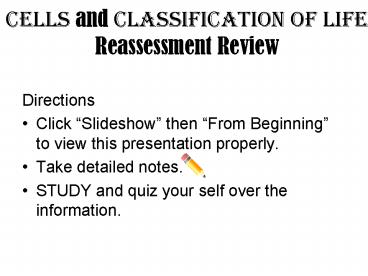Cells and Classification of Life Reassessment Review - PowerPoint PPT Presentation
Title:
Cells and Classification of Life Reassessment Review
Description:
Cells and Classification of Life Reassessment Review Directions Click Slideshow then From Beginning to view this presentation properly. – PowerPoint PPT presentation
Number of Views:152
Avg rating:3.0/5.0
Title: Cells and Classification of Life Reassessment Review
1
Cells and Classification of Life Reassessment
Review
- Directions
- Click Slideshow then From Beginning to view
this presentation properly. - Take detailed notes.
- STUDY and quiz your self over the information.
2
CELLS
3
Prokaryotic Cells Single-celled organisms that
do not have membrane-bound internal structures
no nucleus simple cells with very little
organization of the materials inside.EXAMPLE
bacteria
PROKARYOTIC CELLS
4
Eukaryotic Cells cells that have organelles
contain nucleus cells with organized
structuresEXAMPLES Protists, Animals, Plants,
and Fungi
EUKARYOTIC CELLS
5
Cell Parts
6
Cytoplasm All cells contain cytoplasm. It is a
clear gel-like fluid (liquid) which takes up most
space inside the cell, where many cell reactions
and where organelles are located
CYTOPLASM
7
Nucleus Only eukaryotic cells have a nucleus.
control center of cell brain of cell usually
located near center of cell controls cell
activity contains DNA (deoxyribonucleic acid).
Nucleus
8
Cell membrane All cells have a cell membrane.
It is the protective barrier of the cell that
holds it together. It lets good material in and
bad material out.
___ _______
9
Cell Wall stiff outer barrier of a plant cell,
outside of the cell membrane, mostly made up of
cellulose, provides extra support and gives it
shape surrounds cells of plants, fungi, and
bacteria
Cell Wall
10
DOMAINS
11
The Three Domains of Life
12
The 3 Domains of LifeDomains are the first and
the broadest of classifications.
- One domain is Archea, which is composed of the
organisms in the Kingdom Archeabacteria. - Bacteria is the second prokaryotic domain and is
also composed of single kingdom Eubacteria. - The third domain, Eukarya, contains all four of
the eukaryotic kingdoms Animalia (animals),
Fungi (fungi), Plantae (plants), and Protista
(protists).
13
KINGDOMS
14
The 6 Kingdoms of Life
15
The Kingdoms of Life
- Biologists have further classified living things
into six groups called Kingdoms. - Biologists group organisms into six Kingdoms
based on the following - Cell Type
- Organisms are either prokaryotes or eukaryotes.
- Cell Number
- Organisms are either unicellular or
multicellular. - Nutrition
- Organisms are either autotrophs or heterotrophs.
16
6 KINGDOMS
Kingdom a system used to classify and organize
different organisms found on Earth into groups
- Archeabacteria
- Eubacteria
- Protista
- Fungi
- Plantae
- Animalia
17
Kingdom Archaeabacteria
- Contains all of Domain
Archae. - Archaebacteria are
prokaryotes that live in
very harsh conditions.
18
Kingdom Eubacteria
- Contains all of Domain Bacteria.
- Bacteria are prokaryotes and have no internal
nucleus. - Bacteria are found in practically every
environment on Earth.
19
Kingdom Fungi
- Single or multi-celled organisms
- Reproduce by spores
- Heterotrophs that eat dead or living organisms -
decomposer - Yeasts, molds, mushrooms
20
Kingdom Plantae
- multi-cellular organisms
- surrounded by a cell wall
- make their own food (photosynthesis)
- Eukaryotes
- Mosses, ferns, conifers, and flowering plants
- Flowering plants produce seeds in flowers
conifers make seeds in cones mosses and ferns
reproduce by spores
21
Kingdom Animalia
- multi-cellular organisms
- eukaryotes
- get energy from other organisms (omnivores)
22
Kingdom Protista
- mostly single-celled organisms
- eukaryotes
- Some feed on other organisms ex. Amoeba and
paramecium (heterotroph) - Some make their own food (photosynthesis) ex.
Euglena and algae (autotroph)































